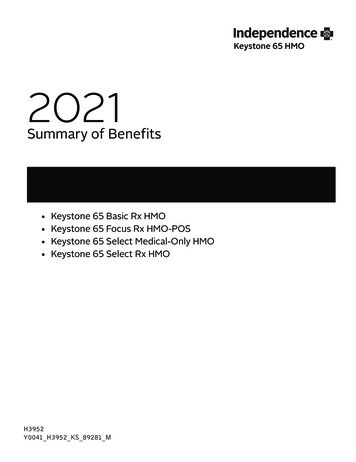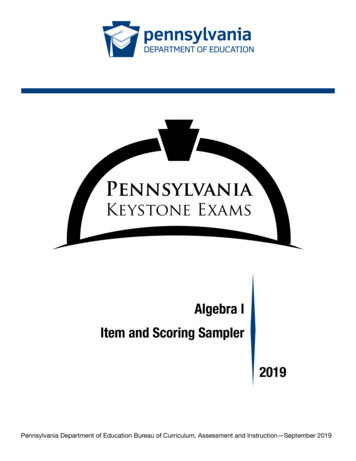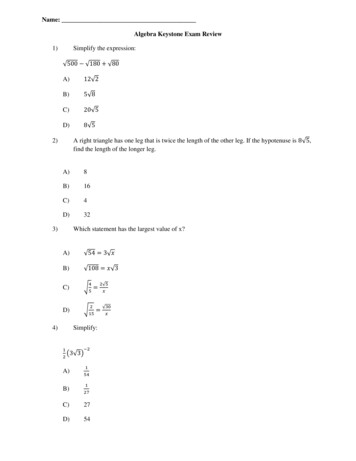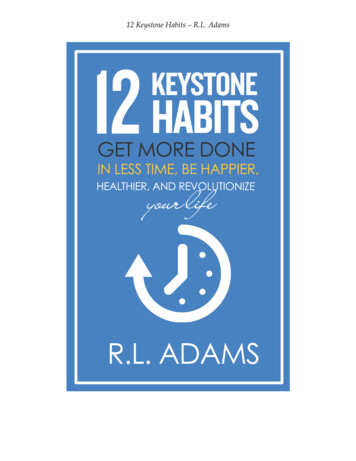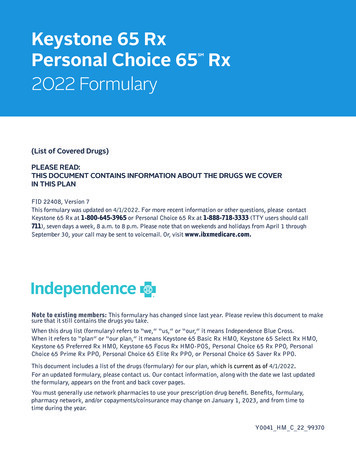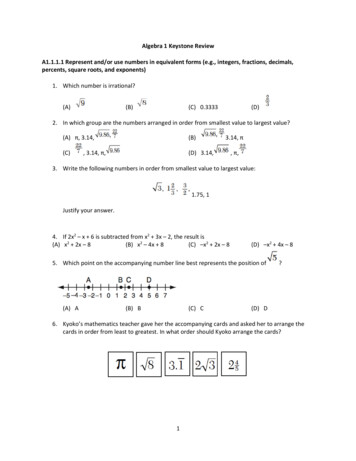
Transcription
Keystone Exams: Algebra IAssessment Anchors and Eligible Contentwith Sample Questions and GlossaryPennsylvania Department of Educationwww.education.state.pa.usJanuary 2013
PENNSYLVANIA DEPARTMENT OF EDUCATIONGeneral Introduction to the Keystone Exam Assessment AnchorsIntroductionSince the introduction of the Keystone Exams, the Pennsylvania Department of Education (PDE) has beenworking to create a set of tools designed to help educators improve instructional practices and betterunderstand the Keystone Exams. The Assessment Anchors, as defined by the Eligible Content, are one of themany tools the Department believes will better align curriculum, instruction, and assessment practicesthroughout the Commonwealth. Without this alignment, it will not be possible to significantly improve studentachievement across the Commonwealth.How were Keystone Exam Assessment Anchors developed?Prior to the development of the Assessment Anchors, multiple groups of PA educators convened to create aset of standards for each of the Keystone Exams. Enhanced Standards, derived from a review of existingstandards, focused on what students need to know and be able to do in order to be college and career ready.(Note: Since that time, PA Common Core Standards have replaced the Enhanced Standards and reflect thecollege- and career-ready focus.) Additionally, the Assessment Anchors and Eligible Content statements werecreated by other groups of educators charged with the task of clarifying the standards assessed on theKeystone Exams. The Assessment Anchors, as defined by the Eligible Content, have been designed to holdtogether, or anchor, the state assessment system and the curriculum/instructional practices in schools.Assessment Anchors, as defined by the Eligible Content, were created with the following design parameters: Clear: The Assessment Anchors are easy to read and are user friendly; they clearly detail whichstandards are assessed on the Keystone Exams. Focused: The Assessment Anchors identify a core set of standards that can be reasonablyassessed on a large-scale assessment; this will keep educators from having to guess whichstandards are critical. Rigorous: The Assessment Anchors support the rigor of the state standards by assessing higherorder and reasoning skills. Manageable: The Assessment Anchors define the standards in a way that can be easilyincorporated into a course to prepare students for success.How can teachers, administrators, schools, and districts use these Assessment Anchors?The Assessment Anchors, as defined by the Eligible Content, can help focus teaching and learning becausethey are clear, manageable, and closely aligned with the Keystone Exams. Teachers and administrators will bebetter informed about which standards will be assessed. The Assessment Anchors and Eligible Contentshould be used along with the Standards and the Curriculum Framework of the Standards Aligned System(SAS) to build curriculum, design lessons, and support student achievement.The Assessment Anchors and Eligible Content are designed to enable educators to determine when they feelstudents are prepared to be successful in the Keystone Exams. An evaluation of current course offerings,through the lens of what is assessed on those particular Keystone Exams, may provide an opportunity for analignment to ensure student preparedness.Pennsylvania Department of Education—Assessment Anchors and Eligible ContentPage 2
How are the Assessment Anchors organized?The Assessment Anchors, as defined by the Eligible Content, are organized into cohesive blueprints, eachstructured with a common labeling system that can be read like an outline. This framework is organized firstby module, then by Assessment Anchor, followed by Anchor Descriptor, and then finally, at the greatest levelof detail, by an Eligible Content statement. The common format of this outline is followed across the KeystoneExams.Here is a description of each level in the labeling system for the Keystone Exams: Module: The Assessment Anchors are organized into two thematic modules for each of theKeystone Exams. The module title appears at the top of each page. The module level is importantbecause the Keystone Exams are built using a module format, with each of the Keystone Examsdivided into two equal-size test modules. Each module is made up of two or more AssessmentAnchors. Assessment Anchor: The Assessment Anchor appears in the shaded bar across the top of eachAssessment Anchor table. The Assessment Anchors represent categories of subject matter thatanchor the content of the Keystone Exams. Each Assessment Anchor is part of a module and hasone or more Anchor Descriptors unified under it. Anchor Descriptor: Below each Assessment Anchor is a specific Anchor Descriptor. The AnchorDescriptor level provides further details that delineate the scope of content covered by theAssessment Anchor. Each Anchor Descriptor is part of an Assessment Anchor and has one or moreEligible Content statements unified under it. Eligible Content: The column to the right of the Anchor Descriptor contains the Eligible Contentstatements. The Eligible Content is the most specific description of the content that is assessed onthe Keystone Exams. This level is considered the assessment limit and helps educators identify therange of the content covered on the Keystone Exams. PA Common Core Standard: In the column to the right of each Eligible Content statement is acode representing one or more PA Common Core Standards that correlate to the Eligible Contentstatement. Some Eligible Content statements include annotations that indicate certain clarificationsabout the scope of an Eligible Content. “e.g.” (“for example”)—sample approach, but not a limit to the Eligible Content“i.e.” (“that is”)—specific limit to the Eligible Content“Note”—content exclusions or definable range of the Eligible ContentHow do the K–12 Pennsylvania Common Core Standards affect this document?Assessment Anchor and Eligible Content statements are aligned to the PA Common Core Standards; thus,the former enhanced standards are no longer necessary. Within this document, all standard references reflectthe PA Common Core Standards.Standards Aligned System—www.pdesas.orgPennsylvania Department of Education—www.education.state.pa.usPennsylvania Department of Education—Assessment Anchors and Eligible ContentPage 3
Keystone Exams: Algebra IFORMULA SHEETFormulas that you may need to work questions in this document are found below.You may use calculator π or the number 3.14.Arithmetic PropertiesA lwwAdditive Inverse:a (ˉa) 0lMultiplicative Inverse:Commutative Property:hV lwhAssociative Property:wlIdentity Property:Linear EquationsSlope:m y2 – y1x2 – x1Point-Slope Formula:Slope-Intercept Formula:y mx bStandard Equation of a Line:Ax By Ca b b aa·b b·a(a b) c a (b c)(a · b) · c a · (b · c)a 0 aa·1 aDistributive Property:(y – y 1) m(x – x 1)1a· 1aa · (b c) a · b a · cMultiplicative Property of Zero:a·0 0Additive Property of Equality:If a b, then a c b cMultiplicative Property of Equality:If a b, then a · c b · cPennsylvania Department of Education—Assessment Anchors and Eligible ContentPage 4
Keystone Exams: Algebra IMODULE 1—Operations and Linear Equations & InequalitiesASSESSMENT ANCHORA1.1.1Operations with Real Numbers and ExpressionsAnchor DescriptorA1.1.1.1Represent and/or useA1.1.1.1.1numbers in equivalentforms (e.g., integers,fractions, decimals,percents, square roots, A1.1.1.1.2and exponents).Eligible ContentCompare and/or order any real numbers.Note: Rational and irrational may bemixed.}PA HS.F.1CC.2.1.HS.F.2}Simplify square roots (e.g., Ï24 2Ï 6 ).Sample Exam QuestionsStandard A1.1.1.1.1Which of the following inequalities is true for all realvalues of x?3Standard A1.1.1.1.2An expression is shown below.}2Ï51x2A. x xB. 3x2 2x3C. (2x)2 3x2D. 3(x – 2)2 3x2 – 2Which}value of x makes the expression equivalentto 10Ï51 ?A. 5B. 25C. 50D. 100An expression is shown below.}Ï87xFor which value of x should the expression befurther simplified?A. x 10B. x 13C. x 21D. x 38Pennsylvania Department of Education—Assessment Anchors and Eligible ContentPage 5
Keystone Exams: Algebra IMODULE 1—Operations and Linear Equations & InequalitiesASSESSMENT ANCHORA1.1.1Operations with Real Numbers and ExpressionsAnchor DescriptorA1.1.1.2Apply number theoryconcepts to showrelationships betweenreal numbers inproblem-solvingsettings.Eligible ContentA1.1.1.2.1Find the Greatest Common Factor (GCF)and/or the Least Common Multiple (LCM)for sets of monomials.PA CommonCoreStandardsCC.2.1.6.E.3CC.2.1.HS.F.2Sample Exam QuestionStandard A1.1.1.2.1Two monomials are shown below.450x2y53,000x4y3What is the least common multiple (LCM) of thesemonomials?A. 2xyB. 30xyC. 150x2y3D. 9,000x4y5Pennsylvania Department of Education—Assessment Anchors and Eligible ContentPage 6
Keystone Exams: Algebra IMODULE 1—Operations and Linear Equations & InequalitiesASSESSMENT ANCHORA1.1.1Operations with Real Numbers and ExpressionsAnchor DescriptorA1.1.1.3Use exponents, roots,and/or absolute valuesto solve problems.Eligible ContentA1.1.1.3.1Simplify/evaluate expressions involvingproperties/laws of exponents, roots, and/or absolute values to solve problems.Note: Exponents should be integers from–10 to 10.PA 2.8.B.1Sample Exam QuestionStandard A1.1.1.3.1Simplify:}2(2Ï 4 ) –21A.81B.4C. 16D. 32Pennsylvania Department of Education—Assessment Anchors and Eligible ContentPage 7
Keystone Exams: Algebra IMODULE 1—Operations and Linear Equations & InequalitiesASSESSMENT ANCHORA1.1.1Operations with Real Numbers and ExpressionsAnchor DescriptorA1.1.1.4Use estimationstrategies in problemsolving situations.Eligible ContentA1.1.1.4.1Use estimation to solve problems.PA CommonCoreStandardsCC.2.2.7.B.3CC.2.2.HS.D.9Sample Exam QuestionStandard A1.1.1.4.1A theme park charges 52 for a day pass and 110for a week pass. Last month, 4,432 day passeswere sold and 979 week passes were sold. Which isthe closest estimate of the total amount of moneypaid for the day and week passes for last month?A. 300,000B. 400,000C. 500,000D. 600,000Pennsylvania Department of Education—Assessment Anchors and Eligible ContentPage 8
Keystone Exams: Algebra IMODULE 1—Operations and Linear Equations & InequalitiesASSESSMENT ANCHORA1.1.1Operations with Real Numbers and ExpressionsAnchor DescriptorA1.1.1.5Simplify expressionsinvolving polynomials.Eligible ContentA1.1.1.5.1Add, subtract, and/or multiply polynomialexpressions (express answers in simplestform).Note: Nothing larger than a binomialmultiplied by a trinomial.A1.1.1.5.2Factor algebraic expressions, includingdifference of squares and trinomials.Note: Trinomials are limited to the formax2 bx c where a is equal to 1 afterfactoring out all monomial factors.A1.1.1.5.3Simplify/reduce a rational algebraicexpression.PA 2.HS.D.3CC.2.2.HS.D.5CC.2.2.HS.D.6Sample Exam QuestionsStandard A1.1.1.5.1A polynomial expression is shown below.Standard A1.1.1.5.3Simplify:–3x3 9 x2 30x; x –4, –2, 0}}–3x3 – 18 x2 – 24x(mx3 3) (2x2 5x 2) – (8x5 20x4 )The expression is simplified to 8x3 6x2 15x 6.What is the value of m?A. –8B. –4C. 4D. 8Standard A1.1.1.5.21 x2 – 5 xA. – }}245B. x3 – 1} x2 – } x24x 5C. }x–4x–5D. }x 4When the expression x2 – 3x – 18 is factoredcompletely, which is one of its factors?A. (x – 2)B. (x – 3)C. (x – 6)D. (x – 9)Pennsylvania Department of Education—Assessment Anchors and Eligible ContentPage 9
Keystone Exams: Algebra IMODULE 1—Operations and Linear Equations & InequalitiesASSESSMENT ANCHORA1.1.1Operations with Real Numbers and ExpressionsSample Exam QuestionsStandard A1.1.1Keng creates a painting on a rectangular canvas with a width that is four inches longer than the height, asshown in the diagram below.hh 4A.Write a polynomial expression, in simplified form, that represents the area of the canvas.Keng adds a 3-inch-wide frame around all sides of his canvas.B.Write a polynomial expression, in simplified form, that represents the total area of the canvasand the frame.Continued on next page.Pennsylvania Department of Education—Assessment Anchors and Eligible ContentPage 10
Keystone Exams: Algebra IMODULE 1—Operations and Linear Equations & InequalitiesContinued. Please refer to the previous page for task explanation.Keng is unhappy with his 3-inch-wide frame, so he decides to put a frame with a different width aroundhis canvas. The total area of the canvas and the new frame is given by the polynomial h2 8h 12,where h represents the height of the canvas.C.Determine the width of the new frame. Show all your work. Explain why you did each step.Pennsylvania Department of Education—Assessment Anchors and Eligible ContentPage 11
Keystone Exams: Algebra IMODULE 1—Operations and Linear Equations & InequalitiesStandard A1.1.1The results of an experiment were listed in several numerical forms as listed below.5–3A.4}7}Ï53}80.003Order the numbers listed from least to greatest.Another experiment required evaluating the expression shown below.1 (Ï}} 36 3–2) 43 z–8z6B.What is the value of the expression?value of the expression:Continued on next page.Pennsylvania Department of Education—Assessment Anchors and Eligible ContentPage 12
Keystone Exams: Algebra IMODULE 1—Operations and Linear Equations & InequalitiesContinued. Please refer to the previous page for task explanation.}The final experiment required simplifying 7Ï 425 . The steps taken are shown below.7 425step 1:7400 step 2:7(20 5)step 3:7(25)step 4:17525)One of the steps shown is incorrect.C.Rewrite the incorrect step so that it is correct.correction:D.}Using the corrected step from part C, simplify 7Ï425 .}7Ï425 Pennsylvania Department of Education—Assessment Anchors and Eligible ContentPage 13
Keystone Exams: Algebra IMODULE 1—Operations and Linear Equations & InequalitiesASSESSMENT ANCHORA1.1.2Linear EquationsAnchor DescriptorA1.1.2.1PA CommonCoreStandardsWrite, solve, and/or apply a linear equation CC.2.1.HS.F.3CC.2.1.HS.F.4(including problem situations).CC.2.1.HS.F.5Use and/or identify an algebraic property CC.2.2.8.B.3CC.2.2.8.C.1to justify any step in an ote: Linear equations only.CC.2.2.HS.D.7CC.2.2.HS.D.8Interpret solutions to problems in theCC.2.2.HS.D.9context of the problem situation.CC.2.2.HS.D.10Note: Linear equations only.Eligible ContentWrite, solve, and/orA1.1.2.1.1graph linear equationsusing various methods.A1.1.2.1.2A1.1.2.1.3Sample Exam QuestionsStandard A1.1.2.1.1Jenny has a job that pays her 8 per hour plustips (t). Jenny worked for 4 hours on Monday andmade 65 in all. Which equation could be used tofind t, the amount Jenny made in tips?Standard A1.1.2.1.2One of the steps Jamie used to solve an equation isshown below.–5(3x 7) 10–15x –35 10A. 65 4t 8B. 65 8t 4C. 65 8t 4D. 65 8(4) tWhich statements describe the procedure Jamieused in this step and identify the property thatjustifies the procedure?A. Jamie added –5 and 3x to eliminate theparentheses. This procedure is justified by theassociative property.B. Jamie added –5 and 3x to eliminate theparentheses. This procedure is justified by thedistributive property.C. Jamie multiplied 3x and 7 by –5 to eliminate theparentheses. This procedure is justified by theassociative property.D. Jamie multiplied 3x and 7 by –5 to eliminate theparentheses. This procedure is justified by thedistributive property.Pennsylvania Department of Education—Assessment Anchors and Eligible ContentPage 14
Keystone Exams: Algebra IMODULE 1—Operations and Linear Equations & InequalitiesSample Exam QuestionStandard A1.1.2.1.3Francisco purchased x hot dogs and y hamburgersat a baseball game. He spent a total of 10. Theequation below describes the relationship betweenthe number of hot dogs and the number ofhamburgers purchased.3x 4y 10The ordered pair (2, 1) is a solution of the equation.What does the solution (2, 1) represent?A. Hamburgers cost 2 times as much as hot dogs.B. Francisco purchased 2 hot dogs and1 hamburger.C. Hot dogs cost 2 each, and hamburgers cost 1 each.D. Francisco spent 2 on hot dogs and 1 onhamburgers.Pennsylvania Department of Education—Assessment Anchors and Eligible ContentPage 15
Keystone Exams: Algebra IMODULE 1—Operations and Linear Equations & InequalitiesASSESSMENT ANCHORA1.1.2Linear EquationsAnchor DescriptorA1.1.2.2Write, solve, and/orgraph systems oflinear equations usingvarious methods.Eligible ContentA1.1.2.2.1Write and/or solve a system of linearequations (including problem situations)using graphing, substitution, and/orelimination.Note: Limit systems to two linearequations.A1.1.2.2.2Interpret solutions to problems in thecontext of the problem situation.Note: Limit systems to two linearequations.PA .HS.D.7CC.2.2.HS.D.9CC.2.2.HS.D.10Sample Exam QuestionsStandard A1.1.2.2.1Standard A1.1.2.2.2Anna burned 15 calories per minute running forx minutes and 10 calories per minute hiking fory minutes. She spent a total of 60 minutes runningand hiking and burned 700 calories. The system ofequations shown below can be used to determinehow much time Anna spent on each exercise.15x 10y 700x y 60What is the value of x, the minutes Anna spentrunning?Samantha and Maria purchased flowers. Samanthapurchased 5 roses for x dollars each and 4 daisiesfor y dollars each and spent 32 on the flowers.Maria purchased 1 rose for x dollars and 6 daisiesfor y dollars each and spent 22. The system ofequations shown below represents this situation.5x 4y 32x 6y 22Which statement is true?A. A rose costs 1 more than a daisy.A. 10B. 20C. 30D. 40B. Samantha spent 4 on each daisy.C. Samantha spent more on daisies than she didon roses.D. Samantha spent over 4 times as much ondaisies as she did on roses.Pennsylvania Department of Education—Assessment Anchors and Eligible ContentPage 16
Keystone Exams: Algebra IMODULE 1—Operations and Linear Equations & InequalitiesASSESSMENT ANCHORA1.1.2Linear EquationsSample Exam QuestionsStandard A1.1.2Nolan has 15.00. He earns 6.00 an hour babysitting. The equation below can be used to determine howmuch money in dollars (m) Nolan has after any number of hours of babysitting (h).m 6h 15A.After how many hours of babysitting will Nolan have 51.00?hours:Claire has 9.00. She makes 8.00 an hour babysitting.B.Use the system of linear equations below to find the number of hours of babysitting after whichNolan and Claire will have the same amount of money.m 6h 15m 8h 9hours:Continued on next page.Pennsylvania Department of Education—Assessment Anchors and Eligible ContentPage 17
Keystone Exams: Algebra IMODULE 1—Operations and Linear Equations & InequalitiesContinued. Please refer to the previous page for task explanation.The graph below displays the amount of money Alex and Pat will each have saved after their hours ofbabysitting.Money Saved (in Dollars)m50454035302520151050C.Money SavedKeyAlex’s money savedPat’s money saved1 2 3 4 5 6 7 8 9 10HourshBased on the graph, for what domain (h) will Alex have more money saved than Pat? Explain yourreasoning.Pennsylvania Department of Education—Assessment Anchors and Eligible ContentPage 18
Keystone Exams: Algebra IMODULE 1—Operations and Linear Equations & InequalitiesStandard A1.1.2The diagram below shows 5 identical bowls stacked one inside the other.Bowls5 inches2 inchesThe height of 1 bowl is 2 inches. The height of a stack of 5 bowls is 5 inches.A.Write an equation using x and y to find the height of a stack of bowls based onany number of bowls.equation:Continued on next page.Pennsylvania Department of Education—Assessment Anchors and Eligible ContentPage 19
Keystone Exams: Algebra IMODULE 1—Operations and Linear Equations & InequalitiesContinued. Please refer to the previous page for task explanation.B.Describe what the x and y variables represent.x-variable:y-variable:C.What is the height, in inches, of a stack of 10 bowls?height:inchesPennsylvania Department of Education—Assessment Anchors and Eligible ContentPage 20
Keystone Exams: Algebra IMODULE 1—Operations and Linear Equations & InequalitiesASSESSMENT ANCHORA1.1.3Linear InequalitiesAnchor DescriptorA1.1.3.1Eligible ContentWrite, solve, and/orA1.1.3.1.1graph linear inequalitiesusing various methods.Write or solve compound inequalitiesand/or graph their solution sets on anumber line (may include absolute valueinequalities).A1.1.3.1.2Identify or graph the solution set to alinear inequality on a number line.A1.1.3.1.3Interpret solutions to problems in thecontext of the problem situation.Note: Linear inequalities only.PA 2.HS.D.9CC.2.2.HS.D.10Sample Exam QuestionsStandard A1.1.3.1.1A compound inequality is shown below.Standard A1.1.3.1.35 2 – 3y 14What is the solution of the compound inequality?A. –4 y –1A baseball team had 1,000 to spend on supplies.The team spent 185 on a new bat. New baseballscost 4 each. The inequality 185 4b 1,000 canbe used to determine the number of newbaseballs (b) that the team can purchase. Whichstatement about the number of new baseballs thatcan be purchased is true?B. –4 y –1A. The team can purchase 204 new baseballs.C. 1 y 4B. The minimum number of new baseballs thatcan be purchased is 185.D. 1 y 4Standard A1.1.3.1.2The solution set of an inequality is graphed on thenumber line below.–5–4–3–2–101C. The maximum number of new baseballs thatcan be purchased is 185.D. The team can purchase 185 new baseballs, butthis number is neither the maximum nor theminimum.2The graph shows the solution set of whichinequality?A. 2x 5 –1B. 2x 5 –1C. 2x 5 –1D. 2x 5 –1Pennsylvania Department of Education—Assessment Anchors and Eligible ContentPage 21
Keystone Exams: Algebra IMODULE 1—Operations and Linear Equations & InequalitiesASSESSMENT ANCHORA1.1.3Linear InequalitiesAnchor DescriptorA1.1.3.2Write, solve, and/orA1.1.3.2.1graph systems oflinear inequalities usingvarious methods.A1.1.3.2.2Eligible ContentWrite and/or solve a system of linearinequalities using graphing.Note: Limit systems to two linearinequalities.Interpret solutions to problems in thecontext of the problem situation.Note: Limit systems to two linearinequalities.Pennsylvania Department of Education—Assessment Anchors and Eligible ContentPA 2.HS.D.10Page 22
Keystone Exams: Algebra IMODULE 1—Operations and Linear Equations & InequalitiesSample Exam QuestionStandard A1.1.3.2.1A system of inequalities is shown below.y x–6y –2xWhich graph shows the solution set of the system of .1 2 3 4 5 6 7 8 3–4–5–6–7–8–91 2 3 4 5 6 7 8 1–2–3–4–5–6–7–8–9D.987654321y1 2 3 4 5 6 7 8 9x1 2 3 4 5 6 7 8 �1–2–3–4–5–6–7–8–9Pennsylvania Department of Education—Assessment Anchors and Eligible ContentPage 23
Keystone Exams: Algebra IMODULE 1—Operations and Linear Equations & InequalitiesSample Exam QuestionStandard A1.1.3.2.2Tyreke always leaves a tip of between 8% and 20%for the server when he pays for his dinner. This canbe represented by the system of inequalities shownbelow, where y is the amount of tip and x is thecost of dinner.y 0.08xy 0.2xWhich of the following is a true statement?A. When the cost of dinner ( x) is 10, the amountof tip ( y) must be between 2 and 8.B. When the cost of dinner ( x) is 15, the amountof tip ( y) must be between 1.20 and 3.00.C. When the amount of tip ( y) is 3, the cost ofdinner ( x) must be between 11 and 23.D. When the amount of tip ( y) is 2.40, the cost ofdinner ( x) must be between 3 and 6.Pennsylvania Department of Education—Assessment Anchors and Eligible ContentPage 24
Keystone Exams: Algebra IMODULE 1—Operations and Linear Equations & InequalitiesASSESSMENT ANCHORA1.1.3Linear InequalitiesSample Exam QuestionsStandard A1.1.3An apple farm owner is deciding how to use each day’s harvest. She can use the harvest to produce applejuice or apple butter. The information she uses to make the decision is listed below. A bushel of apples will make 16 quarts of apple juice.A bushel of apples will make 20 pints of apple butter.The apple farm can produce no more than 180 pints of apple butter each day.The apple farm harvests no more than 15 bushels of apples each day.The information given can be modeled with a system of inequalities. When x is the number of quarts ofapple juice and y is the number of pints of apple butter, two of the inequalities that model the situationare x 0 and y 0.A.Write two more inequalities to complete the system of inequalities modeling the information.inequalities:B.Graph the solution set of the inequalities from part A below. Shade the area that represents thesolution set.y Apple Farm ProductionPints of Apple Butter30024018012060060 120 180 240 300Quarts of Apple JuicexContinued on next page.Pennsylvania Department of Education—Assessment Anchors and Eligible ContentPage 25
Keystone Exams: Algebra IMODULE 1—Operations and Linear Equations & InequalitiesContinued. Please refer to the previous page for task explanation.The apple farm makes a profit of 2.25 on each pint of apple butter and 2.50 on each quart ofapple juice.C.Explain how you can be certain the maximum profit will be realized when the apple farm produces96 quarts of apple juice and 180 pints of apple butter.Pennsylvania Department of Education—Assessment Anchors and Eligible ContentPage 26
Keystone Exams: Algebra IMODULE 1—Operations and Linear Equations & InequalitiesStandard A1.1.3David is solving problems with inequalities.One of David’s problems is to graph the solution set of an inequality.A.Graph the solution set to the inequality 4x 3 7x – 9 on the number line below.–10 –9 –8 –7 –6 –5 –4 –3 –2 –1 0 1 2 3 4 5 6 7 8 9 10David correctly graphed an inequality as shown below.–10 –9 –8 –7 –6 –5 –4 –3 –2 –1 0 1 2 3 4 5 6 7 8 9 10The inequality David graphed was written in the form 7 B.? 9.What is an expression that could be put in place of the question mark so that the inequality wouldhave the same solution set as shown in the graph?7 9Continued on next page.Pennsylvania Department of Education—Assessment Anchors and Eligible ContentPage 27
Keystone Exams: Algebra IMODULE 1—Operations and Linear Equations & InequalitiesContinued. Please refer to the previous page for task explanation.The solution set to a system of linear inequalities is graphed below.y54321–5 –4 –3 –2 –1–1–2–3–4–5C.1 2 3 4 5xWrite a system of two linear inequalities that would have the solution set shown in the graph.linear inequality 1:linear inequality 2:Pennsylvania Department of Education—Assessment Anchors and Eligible ContentPage 28
Keystone Exams: Algebra IMODULE 2—Linear Functions and Data OrganizationsASSESSMENT ANCHORA1.2.1FunctionsAnchor DescriptorA1.2.1.1Analyze and/or usepatterns or relations.PA CommonCoreStandardsCC.2.2.8.C.1Analyze a set of data for the existenceCC.2.2.8.C.2of a pattern and represent the patternCC.2.2.HS.C.1algebraically and/or graphically.CC.2.2.HS.C.2Determine whether a relation is a function, CC.2.2.HS.C.3given a set of points or a graph.CC.2.4.HS.B.2Eligible ContentA1.2.1.1.1A1.2.1.1.2A1.2.1.1.3Identify the domain or range of a relation(may be presented as ordered pairs, agraph, or a table).Sample Exam QuestionStandard A1.2.1.1.1Tim’s scores the first 5 times he played a videogame are listed below.4,526 4,599 4,672 4,745 4,818Tim’s scores follow a pattern. Which expressioncan be used to determine his score after he playedthe video game n times?A. 73n 4,453B. 73(n 4,453)C. 4,453n 73D. 4,526nPennsylvania Department of Education—Assessment Anchors and Eligible ContentPage 29
Keystone Exams: Algebra IMODULE 2—Linear Functions and Data OrganizationsSample Exam QuestionStandard A1.2.1.1.2Which graph shows y as a function of x?A.B.y4321–4 – 3 –2 – 1–1–2–3–4C.1 2 3 4– 4 –3 – 2 – 1–1–2–3–4D.4321– 4 – 3 –2 – 1–1–2–3–44321xy1 2 3 4xy1 2 3 4xy4321– 4 –3 – 2 – 1–1–2–3–41 2 3 4Pennsylvania Department of Education—Assessment Anchors and Eligible ContentxPage 30
Keystone Exams: Algebra IMODULE 2—Linear Functions and Data OrganizationsSample Exam QuestionStandard A1.2.1.1.3The graph of a function is shown below.y8642–6–4–2246x–2Which value is not in the range of the function?A. 0B. 3C. 4D. 5Pennsylvania Department of Education—Assessment Anchors and Eligible ContentPage 31
Keystone Exams: Algebra IMODULE 2—Linear Functions and Data OrganizationsASSESSMENT ANCHORA1.2.1FunctionsAnchor DescriptorA1.2.1.2Interpret and/or useA1.2.1.2.1linear functions andtheir equations, graphs, A1.2.1.2.2or tables.PA CommonCoreStandardsCreate, interpret, and/or use the equation, CC.2.1.HS.F.3CC.2.1.HS.F.4graph, or table of a linear function.CC.2.2.8.B.2Translate from one representation of aCC.2.2.8.C.1linear function to another (i.e., graph,CC.2.2.8.C.2table, and C.2.2.HS.C.6CC.2.4.HS.B.2Eligible ContentSample Exam QuestionsStandard A1.2.1.2.1A pizza restaurant charges for each pizza and addsa delivery fee. The cost (c), in dollars, to have anynumber of pizzas (p) delivered to a home isdescribed by the function c 8p 3. Whichstatement is true?Standard A1.2.1.2.2The table below shows values of y as afunction of x.A. The cost of 8 pizzas is 11.B. The cost of 3 pizzas is 14.C. Each pizza costs 8, and the delivery fee is 3.D. Each pizza costs 3, and the delivery fee is 8.xy21062514552610034130Which linear equation describes the r
Keystone Exams: Algebra I MODULE 1—Operations and Linear Equations & Inequalities ASSESSMENT ANCHOR A1.1.1 Operations with Real Numbers and Expressions Anchor Descriptor Eligible Content PA Common Core Standards A1.1.1.3 Use exponents, roots, and/or absolute values to solve problems. A1.1.1.3.1 Simplify/evaluate expressions involving
